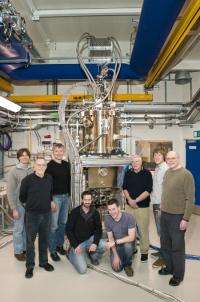300,000 times the strength of the Earth's magnetic field: BLADE's new 14 Tesla magnet

The first researchers to use the new high-field superconducting magnet at Diamond Light Source, the UK’s national synchrotron facility, are searching for “hidden magnetic states”. If found, they will provide important confirmation of a theoretical model which could have important applications in magnetic data storage. Diamond’s BLADE beamline is providing them with the tools for the search.
Consisting of physicists from the University of Southampton, the Clarendon Laboratory at Oxford and the Magnetic Spectroscopy Group at Diamond, the collaboration is looking for a “hidden magnetic state” in a type of magnet that has been identified as an ideal candidate for data storage. The composition of this magnet is such that it provides sufficient energy barriers to prevent thermally activated data loss, with the potential to relieve the present limit on the storage density of hard disk drives.
Professor Graham Bowden from the University of Southampton explains, “We are using the 14 Tesla superconducting magnet on the BLADE beamline to study exchange spring magnets. These are ferromagnetic composites with a nanoscale microstructure. The exchange spring magnet’s multilayers consist of alternating hard and soft-magnetic layers. Such magnets offer additional flexibility in optimising magnetic properties, with possibilities for superior data storage media.
“So far we have identified at least three different classes of exchange spring magnets. Being able to manipulate these states will mean that more than one piece of information can be stored at a given site. There are also “hidden magnetic states”. Accessing these new exchange spring states and switching processes would be an exciting breakthrough in the field of novel magnetic store media. It will provide important confirmation of the theoretical model developed for exchange spring magnets at Southampton.”
“The first results on the new high-field superconducting magnet represent an important milestone, not only for the beamline, but for the whole of Diamond. Its magnetic field of 14 Tesla is 300,000 times stronger than the earth’s magnetic field, and about six times stronger than the saturation magnetization of high purity iron. It will also record the lowest temperature at Diamond of 300 milliKelvin – a chilling minus 272.85 degrees Celsius. The team has worked hard to achieve this milestone and we are really pleased to see that BLADE is playing a key role in important new physics.” said Senior Beamline Scientist on BLADE, Dr Peter Bencok.
More information: www.diamond.ac.uk/Home/Beamlines/I10.html
Members of the collaboration pictured above in front of the superconducting magnet on the BLADE beamline (L-R): Principal Beamline Scientist Dr Paul Steadman, Diamond; Prof. Peter de Groot, Physics Dpt. Southampton; Dr Peter Bencok, Diamond; Dr Leigh Shelford, Diamond Magnetic Spectroscopy Group; Gavin Stenning, Physics Dpt. Southampton; Prof. Graham Bowden, Physics Dpt. Southampton; Simon Gregory, Physics Dpt. Southampton; Prof. Gerrit van der Laan, Diamond Magnetic Spectroscopy Group.
Provided by Diamond Light Source Ltd



















